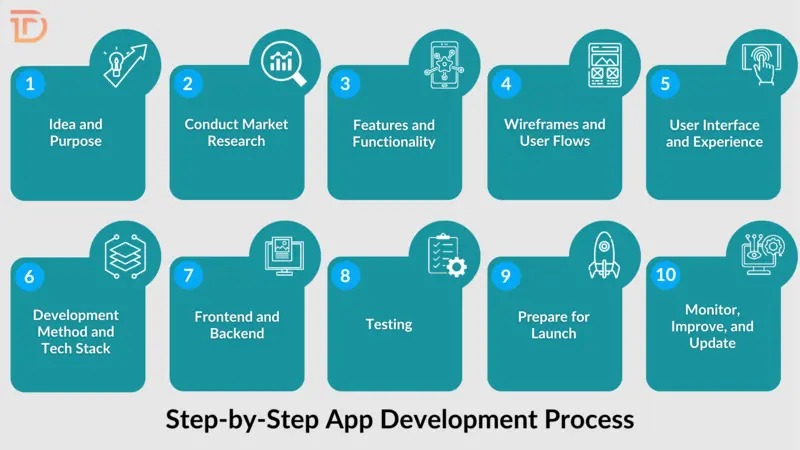Mobile applications have transformed how businesses operate, communicate, and grow. For entrepreneurs with a groundbreaking idea, launching a mobile app can open doors to vast opportunities, global users, and new revenue streams. However, turning a raw idea into a polished, functioning mobile application requires more than just enthusiasm— it demands a clear roadmap, strategic execution, and a deep understanding of the mobile app development process.
This comprehensive guide walks through each essential stage of mobile app development, from the initial concept to the final launch. Whether starting from scratch or refining a business vision, the steps outlined here will provide clarity and direction to aspiring app creators.
How to Develop a Mobile App Step by Step?
The journey begins with identifying a problem and ends with a product that solves it effectively. Here is a detailed look at each phase of the step-by-step mobile app development process:

Clarify the Idea and Purpose
Success starts with a strong idea. However, an idea alone isn’t enough. It must solve a real-world problem or offer value in a unique way.
- Define the core problem the app addresses.
- Identify the target audience who will benefit from using it.
- Outline the primary function and goals of the app.
- Research whether the idea is original or if similar solutions exist.
Clarity at this stage sets the foundation for everything that follows.
Conduct Market Research
Understanding the market landscape is crucial. Before investing time and money, ensure there’s demand for the app idea.
- Analyze competitor apps to understand what works and what doesn’t.
- Study user reviews to find gaps in current offerings.
- Identify opportunities to improve the user experience or introduce innovative features.
- Validate the idea with real users through surveys, interviews, or focus groups.
This research reduces the risk of building something no one needs.
Define Core Features and Functionality
Overloading the app with features can overwhelm users and inflate development costs. Focus instead on a minimum viable product (MVP).
- List all desired features and prioritize the essentials.
- Break the app into core modules (e.g., user registration, search, notifications).
- Identify features for future updates after launch.
This stage helps keep the first version lightweight, focused, and faster to release.
Sketch Wireframes and User Flows
Visualizing how the app will look, and function improves communication between entrepreneurs and developers.
- Create basic wireframes to outline screens and layout.
- Map user flows to understand how users navigate the app.
- Focus on simplicity, intuitive navigation, and ease of use.
This step is where the abstract concept begins to take visual form.
Design the User Interface and Experience (UI/UX)
Design is more than aesthetics— it’s about how users feel when interacting with the app.
- Build high-fidelity mockups with a consistent color scheme, typography, and icons.
- Ensure designs are responsive and fit well across various screen sizes.
- Emphasize intuitive interactions, minimal user effort, and accessibility.
Good design enhances user retention and satisfaction, influencing long-term success.
Choose the Development Method and Tech Stack
Depending on budget, timeline, and features, different approaches can be used to develop the app.
- Decide between native, hybrid, or cross-platform development.
- Choose a tech stack that suits the app’s functionality and performance needs.
- Evaluate developer expertise and project complexity before choosing tools.
The choice here affects performance, scalability, and long-term maintainability.
Begin Development (Frontend and Backend)
Once the designs and tech stack are finalized, coding begins.
- Frontend development handles what users see— interface, animations, and interactions.
- Backend development involves servers, databases, APIs, and user management.
- Both parts must integrate seamlessly to provide a stable and responsive app.
Maintaining clear communication between design and development teams ensures the app stays aligned with its vision.
Test Thoroughly and Rigorously
Testing uncovers bugs, performance issues, and usability problems that could harm the user experience.
- Perform functional testing to ensure features work as expected.
- Conduct usability testing to identify confusing or inefficient design choices.
- Run performance testing under different loads and devices.
- Use beta testing with real users to collect feedback before public release.
Skipping testing can lead to user frustration and bad reviews post-launch.
Prepare for Launch
A successful launch requires more than uploading the app to stores. It demands preparation and a marketing push.
- Set up accounts and fill out listing information for app and play stores.
- Create compelling visuals and descriptions to attract downloads.
- Build a landing page or website to support the app.
- Plan and execute a promotional strategy including email marketing, social media, and influencer outreach.
Launching is a critical moment that determines the app’s initial visibility and momentum.
Monitor, Improve, and Update
The journey doesn’t end at launch. Continuous improvement is key to staying relevant.
- Monitor analytics to track user behavior and engagement.
- Collect user feedback through reviews and in-app surveys.
- Fix bugs and release updates with improved features and performance.
- Use data to inform future development cycles.
Listening to users and adapting quickly keeps the app competitive and valued.
Final Thoughts
Developing a mobile app is both an exciting and challenging journey. Entrepreneurs must wear multiple hats— visionary, strategist, problem-solver, and decision-maker. Partnering with a reliable software and app development company for startups can ease this burden by bringing technical expertise and industry insight to the table. Each step of the mobile app development process plays a vital role in shaping the final product and its success in the market.
Turning an idea into a functional app is more than just hiring developers and writing code. It requires thoughtful planning, continuous feedback, and an ongoing commitment to improvement. Factors such as user experience, scalability, and the cost to develop a custom mobile app must be carefully considered to ensure the end product is both effective and sustainable. Whether launching a tool for productivity, a platform for social connection, or a solution to a niche problem, the principles remain the same.
By following the structured approach outlined in this guide, entrepreneurs can confidently move from idea to launch with clarity and purpose. The path may be demanding, but the reward— a well-crafted app that makes a difference is worth every step.







